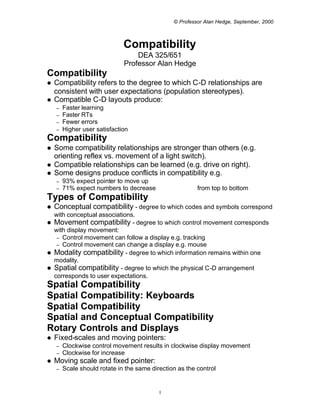More Related Content
Similar to Compatibility (20)
More from Clean Agent Sdn Bhd
More from Clean Agent Sdn Bhd (20)
Compatibility
- 1. © Professor Alan Hedge, September, 2000
Compatibility
DEA 325/651
Professor Alan Hedge
Compatibility
l Compatibility refers to the degree to which C-D relationships are
consistent with user expectations (population stereotypes).
l Compatible C-D layouts produce:
– Faster learning
– Faster RTs
– Fewer errors
– Higher user satisfaction
Compatibility
l Some compatibility relationships are stronger than others (e.g.
orienting reflex vs. movement of a light switch).
l Compatible relationships can be learned (e.g. drive on right).
l Some designs produce conflicts in compatibility e.g.
– 93% expect pointer to move up
– 71% expect numbers to decrease from top to bottom
Types of Compatibility
l Conceptual compatibility - degree to which codes and symbols correspond
with conceptual associations.
l Movement compatibility - degree to which control movement corresponds
with display movement:
– Control movement can follow a display e.g. tracking
– Control movement can change a display e.g. mouse
l Modality compatibility - degree to which information remains within one
modality.
l Spatial compatibility - degree to which the physical C-D arrangement
corresponds to user expectations.
Spatial Compatibility
Spatial Compatibility: Keyboards
Spatial Compatibility
Spatial and Conceptual Compatibility
Rotary Controls and Displays
l Fixed-scales and moving pointers:
– Clockwise control movement results in clockwise display movement
– Clockwise for increase
l Moving scale and fixed pointer:
– Scale should rotate in the same direction as the control
1
- 2. © Professor Alan Hedge, September, 2000
– Scale numbers should increase from left to right
– Clockwise for increase
Rotary Controls and Displays
l All requirements cannot always be satisfied:
Rotary Controls, Linear Displays (Same Plane)
l Warrick's principle - the display pointer moves in the same direction as that
side of the control nearest to it (applies when control is located to the side of the
display):
Rotary Controls, Linear Displays (same plane)
l Scale-by-side principle - the pointer will move in the same direction as the
side of the control knob on the same side as the markings of the display
(applies to top and bottom control locations as well) :
Rotary controls, Linear Displays (same plane)
Stick Controls and Displays
(Different Planes)
Spatial compatibility
l Forklift control - left/right; up/down, but which way?
Recommended C-D Layouts
(Different Planes)
Rotary Controls: Recommended Orientation
Fitt’s Law: Predicting Movement Times
l Movement time is a log function of distance for a constant target
size.
MT = a + blog 2(2D/W)
MT = movement time
a + b = empirically derived constants
D = distance moved from start to target center
W = width of target
Fitt’s Law: Predicting Movement Times
Schmidt’s Law: Movement Speed
l When movements are made that don’t utilize visual feedback,
Schmidt’s Law can be used to predict movement times:
W = a + b(D/MT)
W = effective target width (SD end point dispersion)
a and b = empirically derived constants
D = distance
MT = Movement time
2
- 3. © Professor Alan Hedge, September, 2000
l Describes accuracy for movements between 140-200 ms and up to
12 inches distance.
3

